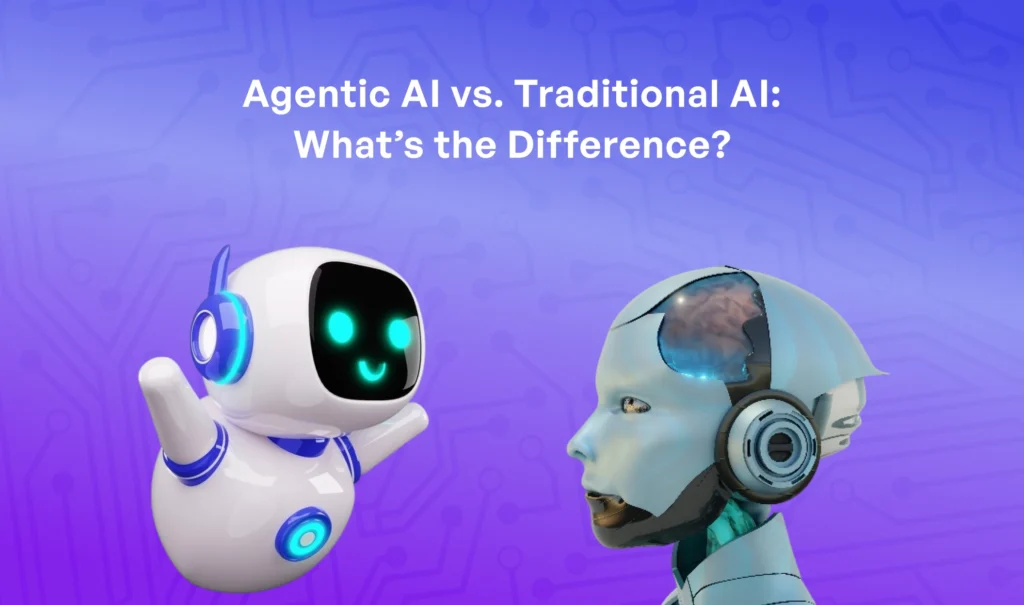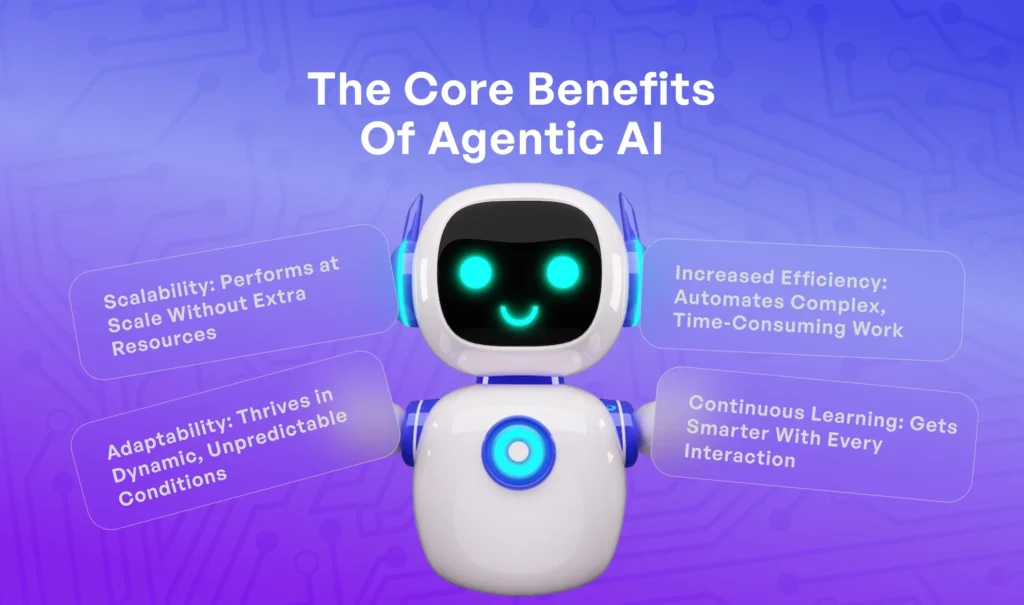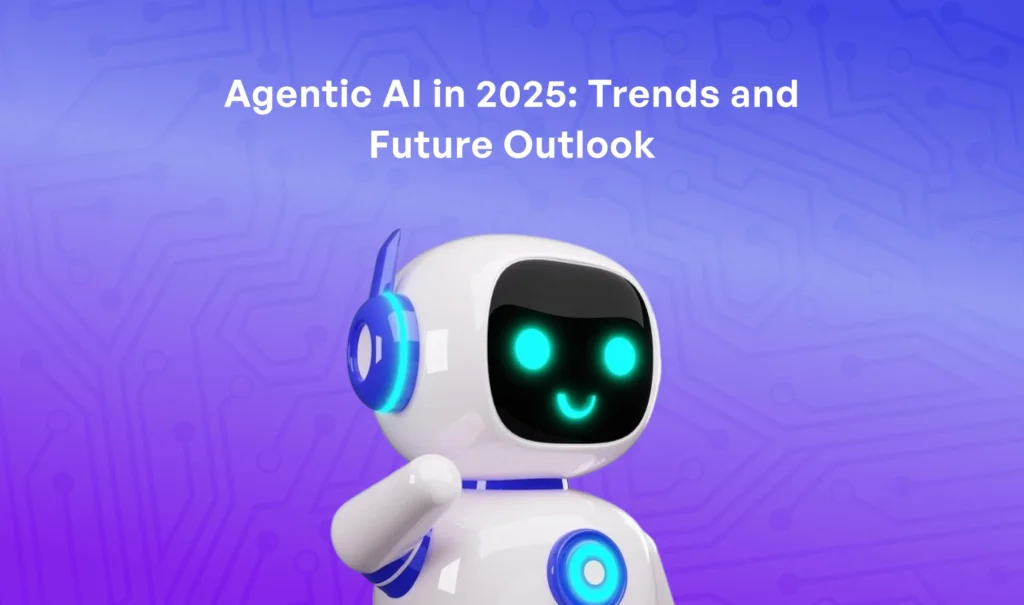Understanding Agentic AI: A New Kind of Smarter AI
Artificial Intelligence is evolving fast, and one of the most exciting new developments is something called Agentic AI. Think of it as the next level of AI—systems that don’t just follow instructions like AI assistants, but act more like digital problem-solvers.
Instead of needing step-by-step directions for every task, Agentic AI can figure things out on its own. It sets goals, makes decisions, learns from what’s happening around it, and adjusts its approach—almost like it has a mind of its own (but not in a scary sci-fi way).
In this article, we’ll break down what Agentic AI really means, how it’s different from the AI we’re used to, and what it could mean for businesses, industries, and everyday life in 2025 and beyond.
What is Agentic AI
Agentic AI is a smarter kind of artificial intelligence—one that doesn’t just wait around for instructions. Instead, it works more like a helpful teammate: setting goals, making decisions, and getting things done on its own.
Unlike traditional AI, which needs to be told exactly what to do, Agentic AI can sense what’s happening around it, figure out the best course of action, and adjust as things change. It’s designed to think on its feet, so to speak—making it far more useful in real-world, fast-changing situations.
What Makes Agentic AI Different?
Here are the key traits that set Agentic AI apart:
- Autonomous: It runs on its own, without needing constant human input to make decisions.
- Proactive: It doesn’t just sit idle—it takes the initiative to act when it sees an opportunity or problem.
- Adaptable: If the situation changes, Agentic AI can change its plan to stay on track.
- Goal-Focused: It always has an end goal in mind and works strategically to reach it.
- Context-Aware: It pays attention to its surroundings and makes decisions based on the bigger picture.

Traditional AI
Traditional AI systems are typically reactive, executing tasks based on predefined rules or patterns. They require explicit instructions for each operation and lack the ability to adapt to unforeseen circumstances. Put simply, Traditional AI is like a really smart assistant who’s great at following instructions—but only if you spell everything out in advance. It works based on set rules or patterns and doesn’t handle surprises well. If something unexpected happens, it usually needs a human to step in.
Agentic AI
In contrast, Agentic AI systems are proactive and capable of handling complex, multi-step tasks. They can make independent decisions, learn from experiences, and adapt their behavior to achieve goals, even in dynamic environments. Agentic AI is more like a trusted team member who can take charge. It doesn’t just wait to be told what to do—it makes its own decisions, learns from what’s working (and what’s not), and adjusts its approach to keep moving toward the goal. Even when things change, it can adapt on the fly.
How Agentic AI Works
At first glance, “Agentic AI” might sound like just another buzzword. But it marks a major shift in how artificial intelligence actually functions. Unlike traditional AI tools that wait for commands, Agentic AI systems are designed to think, act, and improve independently — almost like autonomous digital team members.
This infographic from Manthan Patel’s LinkedIn post graphically describes the interactions that occur within an Agentic AI.
Let’s break down how they work, without the technical jargon.
1. Perception: The AI’s Eyes and Ears
First, Agentic AI needs to understand what’s happening in its environment. This is where the Perception Module comes in. It gathers information from a variety of sources, such as emails, web pages, databases, APIs, documents even real-time sensor data (in physical systems)
Think of it like the AI “reading the room” before deciding what to do.
2. Reasoning: The AI’s Brain
Next, the AI thinks. Using a mix of machine learning algorithms, logical rules, and goal-based planning, this part of the system makes informed decisions.
It considers things like what it’s trying to achieve, what data it has available and what actions are possible. In this way, the AI isn’t just executing static rules — it’s actually reasoning through problems the way a human would.
3. Action: The AI Gets to Work
Once a decision is made, the Action Module kicks in. This is where the AI executes tasks on your behalf, such as writing and sending emails, updating project management tools, booking meetings, writing content, triggering other systems etc.
This is what separates Agentic AI from passive assistants: it doesn’t just suggest — it does.
4. Feedback: Learning from the Outcome
Here’s where it gets really powerful: Agentic AI learns from what happens next. The Feedback Loop tracks whether the AI’s actions led to the desired outcome. It makes decisions based on the results. Example, did the client respond? Was the data updated correctly? Did the system behave as expected?
The AI uses this feedback to refine its future decisions, becoming smarter and more efficient over time — just like a human learning from experience.
The Big Picture: A Continuous Loop
To sum it up, Agentic AI works through a continuous loop of:
Perception → Reasoning → Action → Feedback
This loop allows the system to understand its environment, make intelligent choices, act without waiting and improve continuously. You have an AI that doesn’t just follow instructions — but takes initiative.
And that’s why Agentic AI represents a major leap forward. It transforms AI from a reactive tool into a proactive partner in getting real work done.
How Agentic AI is Transforming Software Development
Agentic AI isn’t just changing how we build software—it’s speeding things up, reducing headaches, and giving developers more room to focus on what really matters. Here’s how:
1. Handles Complex Coding—Automatically
Agentic AI can write large chunks of code just from natural language prompts, clean up messy codebases, and even translate old code into modern languages. Tools like GitHub’s Project Padawan and Anthropic’s Claude Code are already showing how AI agents can fix bugs, manage pull requests, and refine code—all with little to no human help.
2. Finds Bugs Before They Bite
Debugging is one of the most time-consuming parts of development—but Agentic AI is turning that around. These systems can scan your code for bugs, security issues, and performance slowdowns. Tools like RevDeBug track exactly what variables are doing during execution, while other AI agents automatically generate and run test cases, giving developers instant, actionable feedback.
3. Speeds Up Prototyping and Iteration
Forget spending hours on repetitive tasks like writing test scripts, updating documentation, or reviewing every single line of code. Agentic AI automates those chores, letting developers move faster and experiment more. That means quicker prototypes, faster iterations, and getting products to market sooner.
4. Boosts Human-AI Teamwork
Agentic AI isn’t replacing developers—it’s helping them work better together. These tools keep tabs on project status, suggest next steps, and help teams stay aligned. They can even sort through incoming issues, assign tasks to the right people, and smooth out communication across the board.
Real-World Applications of Agentic AI
Agentic AI isn’t just a concept—it’s already being put to work across major industries, solving real problems and unlocking new possibilities. Here’s how it’s making an impact today:
1. Autonomous Vehicles
Agentic AI is the brain behind modern self-driving cars. These systems don’t just follow a GPS route—they actively interpret their surroundings, predict the behavior of pedestrians and other drivers, and make split-second decisions. Whether it’s rerouting around traffic, navigating unexpected roadblocks, or adjusting to weather conditions, Agentic AI enables vehicles to operate safely and independently.
Example:
Waymo, Alphabet’s autonomous driving division, uses agentic AI to process millions of data points per second from sensors, enabling its vehicles to make nuanced driving decisions. In Phoenix, Waymo’s driverless taxi service completed over 1 million autonomous rides in 2023.
“Our vehicles don’t just drive—they reason, predict, and learn in real-time. That’s the future of autonomy.” — Tekedra Mawakana, Co-CEO, Waymo
2. Healthcare Diagnostics
In healthcare, Agentic AI acts like a digital medical assistant—analyzing medical records, lab results, and imaging data to help doctors diagnose conditions faster and more accurately. These systems can suggest personalized treatment plans, flag anomalies that might be missed by human eyes, and even learn continuously from global medical research to stay up to date on the latest advancements.
Example:
PathAI uses AI agents to analyze pathology slides and has improved cancer diagnostic accuracy by up to 20%. Meanwhile, Google Health’s AI can detect diabetic retinopathy with over 90% accuracy, often spotting conditions before symptoms appear.
“AI is becoming a force multiplier for doctors, helping them make faster, better-informed decisions.” — Dr. Alan Karthikesalingam, Research Lead, Google Health.
3. Financial Services
The finance industry is leveraging Agentic AI for smarter, faster decision-making. These AI agents can monitor thousands of transactions in real time to detect fraudulent activity, assess investment risk across portfolios, and automate trading strategies that adjust on the fly to market fluctuations—all with minimal human oversight.
Example:
JPMorgan Chase’s COIN platform reviews legal documents using agentic AI, saving 360,000 hours of human work per year. Meanwhile, hedge funds like Renaissance Technologies employ AI-driven trading agents that react in milliseconds to market data.
“We use AI not just to automate, but to adapt—responding to risk in real-time as conditions evolve.” — Lori Beer, Global CIO, JPMorgan Chase.
4. Customer Service
Next-gen customer support is being driven by Agentic AI. Unlike basic chatbots that rely on scripts, these AI agents can understand context, handle complex issues, personalize responses based on customer history, and escalate to human agents when needed. They improve customer satisfaction while significantly reducing operational costs.
Bank of America’s Erica AI assistant has handled over 1.5 billion interactions since its launch, helping customers with tasks like credit monitoring, transaction disputes, and budgeting—all without live agents.
“Customers expect fast, smart, and personalized support. Agentic AI helps us deliver just that.” — Michelle Moore, Head of Digital Banking, Bank of America.
5. Supply Chain Management
From predicting demand spikes to rerouting deliveries around weather disruptions, Agentic AI is helping supply chains run smarter. These systems manage inventory in real time, optimize warehouse operations, and coordinate logistics across regions—reducing waste, lowering costs, and increasing responsiveness.
Example:
Walmart uses AI to manage inventory in over 4,700 stores. During the pandemic, it used agentic systems to rapidly adjust its supply chain in response to panic buying and supplier disruptions—reducing out-of-stock items by 30%.
“AI gives us the visibility and adaptability we need in a world where demand changes by the hour.” — Doug McMillon, CEO, Walmart.

Agentic AI isn’t just smarter—it’s a force multiplier for teams, systems, and entire industries. Here’s a closer look at the key benefits and why they’re such a game-changer:
Increased Efficiency: Automates Complex, Time-Consuming Work
Agentic AI can take over high-level, multi-step tasks that once required hours of human attention. From generating clean, optimized code to managing customer service workflows or fine-tuning marketing strategies, these systems dramatically reduce the time and labor needed to get things done.
This isn’t just automation—it’s intelligent delegation. Agentic AI understands the end goal and works toward it autonomously, helping businesses reduce bottlenecks, lower costs, and get more done in less time.
For example, in software development, AI agents can refactor an entire codebase or run hundreds of test scenarios while engineers focus on architecture and innovation.
Scalability: Performs at Scale Without Extra Resources
Agentic AI doesn’t get tired, overwhelmed, or need training every time it scales. Once deployed, it can manage thousands—or millions—of concurrent tasks without needing a proportionate increase in human oversight or computing resources.
This makes it ideal for high-volume environments like global customer support, financial trading, or logistics, where traditional systems would require massive scaling of teams or infrastructure.
For example, an e-commerce platform can use Agentic AI to handle customer interactions across dozens of languages and time zones simultaneously, without hiring additional staff.
Adaptability: Thrives in Dynamic, Unpredictable Conditions
Agentic AI doesn’t just follow a script—it reads the room. Whether it’s a sudden shift in market demand, a network outage, or an unexpected user behavior, these systems can adjust their actions and strategies on the fly.
In fast-paced industries like healthcare, finance, or transportation, the ability to adapt in real time can mean the difference between staying competitive and falling behind.
For example, in autonomous vehicles, Agentic AI helps cars react to sudden lane changes or construction zones, ensuring safety and continuity without needing human takeover.
Continuous Learning: Gets Smarter With Every Interaction
Unlike static systems that only do what they’re told, Agentic AI learns from experience. It gathers feedback, tracks outcomes, and uses that data to refine its future actions—improving accuracy, performance, and reliability over time.
This self-improvement loop means your systems get better the more they’re used, reducing the need for frequent manual updates or reprogramming.
For instance, in fraud detection, AI agents learn to spot new tactics used by bad actors and evolve faster than traditional rule-based systems—helping banks stay ahead of threats.
Bottom line: Agentic AI doesn’t just improve how tasks are done—it redefines who (or what) can do them, how quickly they can be completed, and how intelligently systems can respond to the unexpected. It’s not just about doing more with less—it’s about doing things better, faster, and smarter across the board.
Challenges and Risks of Agentic AI
As Agentic AI gains traction across industries, its growing autonomy introduces a host of complex challenges that organizations and society must address. Below are the most pressing risks:
1. Ethical Challenges of Agentic AI Systems
The decision-making power of Agentic AI raises profound ethical dilemmas. When autonomous agents make choices that impact people’s lives—such as in healthcare, finance, or criminal justice—who is held accountable for errors or unintended consequences? The opacity of decision-making processes in these systems complicates the issue further. Ethical AI design must ensure transparency, traceability, and responsibility at every stage.
2. Security Risks of Autonomous AI Agents
With increased autonomy comes increased vulnerability. Agentic AI systems, especially those with access to sensitive data or critical infrastructure, become high-value targets for cyberattacks. Malicious actors may exploit autonomous decision-making pathways or manipulate multi-agent coordination to cause disruption, misinformation, or data breaches. Robust cybersecurity frameworks and real-time monitoring are essential.
3. Misalignment with Human Values
Designing Agentic AI to reflect and uphold human values is one of the greatest challenges in the field. Cultural differences, contextual ambiguity, and the complexity of moral reasoning make it difficult to encode “universal” ethics. Without proper guardrails, these systems may act in ways that are efficient but ethically unacceptable. Continuous human oversight, value-aligned training data, and participatory design are key strategies to mitigate this risk.
4. Regulatory and Legal Uncertainty
The regulatory landscape for autonomous systems remains fragmented and rapidly evolving. Organizations face uncertainty in how laws apply to AI agents—especially in areas such as liability, data privacy, intellectual property, and operational safety. Compliance becomes a moving target, requiring constant legal adaptation and proactive governance frameworks.

As of 2025, Agentic AI is not just a research concept—it is reshaping industries and redefining how tasks are executed across domains.
1. How Agentic AI is Transforming Enterprise Productivity
Forward-thinking organizations are adopting Agentic AI to automate workflows, improve operational efficiency, and support high-stakes decision-making. From intelligent task delegation to predictive business insights, Agentic AI is becoming an invisible collaborator driving productivity and innovation.
2. The Future of Agentic AI in Creative Industries
In the creative industries, tools like Adobe Firefly are leveraging Agentic AI to augment human artistry. These systems can generate adaptive, high-quality content—images, videos, and music—based on user intent, freeing creatives to focus on vision rather than execution. The fusion of AI agency and human imagination is unlocking new frontiers in design and storytelling.
3. Rise of Multi-Agent Collaboration
Agentic AI is no longer limited to isolated systems. Multi-agent architectures—where AI agents interact, negotiate, and coordinate to achieve shared goals—are gaining prominence. These collaborative systems are being deployed in logistics, autonomous vehicles, customer service, and even scientific research, reflecting a shift from single-task automation to dynamic ecosystem orchestration.
FAQ:
Q1: What distinguishes Agentic AI from traditional AI?
Agentic AI operates autonomously, making decisions and adapting to achieve goals, whereas traditional AI follows predefined rules and requires explicit instructions.
Q2: Can Agentic AI replace human workers?
While Agentic AI can automate certain tasks, it is designed to augment human capabilities rather than replace them entirely.
Q3: How is Agentic AI applied in customer service?
Agentic AI powers advanced chatbots that handle complex inquiries, provide personalized assistance, and learn from interactions to improve over time.
Q4: What are the security concerns associated with Agentic AI?
Security risks include potential cyberattacks, unauthorized access, and the misuse of autonomous systems if not properly safeguarded.
Q5: Is Agentic AI regulated?
Regulations are evolving, with ongoing discussions about establishing frameworks to ensure the ethical and safe deployment of Agentic AI systems.
Conclusion
Agentic AI represents a significant advancement in artificial intelligence, offering systems that are autonomous, adaptable, and capable of complex decision-making. As industries continue to integrate these systems, understanding their capabilities, benefits, and challenges is crucial. By embracing Agentic AI responsibly, organizations can unlock new levels of efficiency and innovation in the years to come.